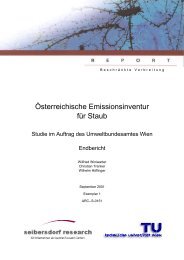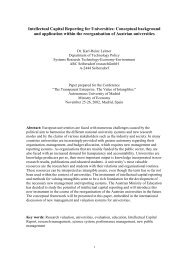ALPMON FINAL REPORT - ARC systems research
ALPMON FINAL REPORT - ARC systems research
ALPMON FINAL REPORT - ARC systems research
You also want an ePaper? Increase the reach of your titles
YUMPU automatically turns print PDFs into web optimized ePapers that Google loves.
Contract ENV4-CT96-0359 <strong>ALPMON</strong><br />
The costs of acquisition of homogeneous morphological, geological, soil and climate information over<br />
the Alpine regions should be certainly huge but they could be paid off along several decades because<br />
these information are durable and, like land cover, they could be applied for the assessment of other<br />
critical environmental risks like run-off, floods and avalanches.<br />
From this point of view the periodical use of remote sensing technology every few years (1-5) for land<br />
cover updating over Alpine areas is surely the most cost-effective approach even though some limiting<br />
factors to the use of satellite imagery in mountain areas last for the moment, like a significant<br />
percentage of shadowed areas (e.g. in Cordevole test site nearly 10% of areas are permanently<br />
shadowed) and a rather low probability to have fine weather conditions during satellite acquisitions<br />
(e.g. in Veneto, only 20% of Thematic Mapper imagery is cloud free).<br />
The erosion risk model FSTAB developed during this feasibility study was aimed to take into account a<br />
wide range of mass erosion phenomena specific of Alpine areas. It must be pointed out that the<br />
FSTAB differs from other erosion models because it does not provide an erosion rate index, which<br />
would not in any case help preventing natural disasters, but an index (MEHI) representing the<br />
propensity towards the generation of mass erosion.<br />
To allow the model to represent the erosion risk inside the test site area of Cordevole with a level of<br />
detail (scale 1:25.000) compatible with the customer requirements, which deal with the regional<br />
planning of hydro-geological defence, were necessary both a calibration based on a geological ground<br />
survey and a quite complex tuning of the fuzzy inference engine. The ground survey consisted in 115<br />
points spread over 265 Km 2 with an average density of 0.43 points per Km 2 . The density of ground<br />
points is a function of the complexity of the geomorphological features present in the study area as well<br />
as of the required accuracy for the final erosion risk index. The tuning of the fuzzy inference engine<br />
must be carried out by an expert geologist with the following skills: 1) sound background on mass<br />
erosion phenomena; 2) general knowledge of the geomorphic processes present in the study area; 3)<br />
good knowledge of principles of fuzzy set logic.<br />
The FSTAB model was not conceived to work over bare rocks and slopes deeper than 45° because on<br />
these areas rock falls are prevailing over mass erosion and these two phenomena are too different to<br />
be considered by the same model. Therefore the full modelling of both mass erosion and rock falls<br />
phenomena should require the integration of a further model.<br />
The application of Discriminant Analysis in sub-model DA provided good results for the land zoning<br />
giving a stability index which is strictly representative of the local intrinsic features. The value of DA<br />
index could be even used alone as local stability index, anyway it cannot account for changes in<br />
infiltration potential related to critical run-off events and needs therefore to be integrated to the SCS-<br />
CN sub-model.<br />
Fuzzy methods provided a good solution to the integration of the two sub-models. After a first<br />
integration, the implementation of two separated sets of fuzzy inference rules was tested: the first for<br />
debris flows and the second for all the other areas. Debris flows areas were discriminated using the<br />
geomorphological map. This approach can be justified by the time difference which normally<br />
differentiates debris flows from other slower mass movements. The problem of two different time<br />
scales was solved introducing two diverse run-off thresholds.<br />
In order to assess the erosion risk over the whole Alpine area, the erosion model should be flexible to<br />
fit input data with very different accuracy. FSTAB has demonstrated to be a rather flexible model, as<br />
compared to other erosion models like RUSLE, because some input parameters potentially affecting<br />
the mass erosion risk can be even discarded, when their accuracy is not enough good, without prevent<br />
the model from working. This was the case of the parameter ‘surface convexity’ which can significantly<br />
affect the dynamics of surface water flow. In fact the surface convexity in Alpine areas characterised<br />
by complex morphology must be estimated with high accuracy from a very high resolution Digital<br />
Elevation Model. The pixel resolution of DEM should be around 5 metres i.e. the source topographic<br />
map should be at scale 1:5000. In the test site area of Cordevole the DEM was derived from a<br />
topographic map at 1:25.000 scale so it was non accurate enough to estimate surface convexity,<br />
therefore this parameter was not taken into account.<br />
JR, RSDE, ALU, LMU, Seibersdorf, WSL 52




